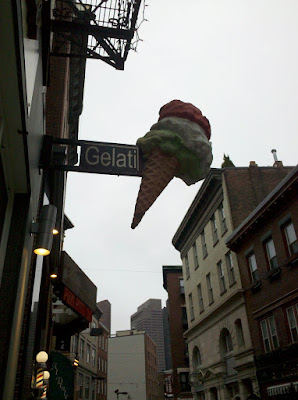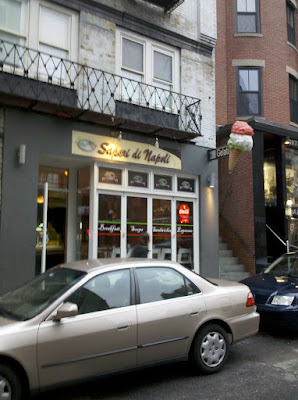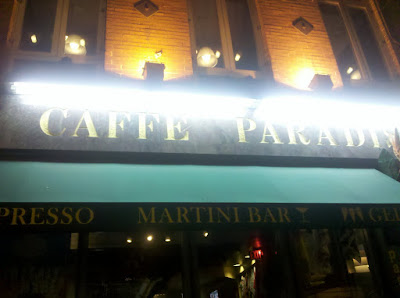Making ice cream educational
We’ve had some literary agents and some editors tell us (well, actually, pretty much all the agents and editors we’ve ever talked to have told us) that education isn’t fun, and it simply doesn’t sell. It’s boring. Kids don’t like it. Parents aren’t interested. What a dull perspective on travel, eh? Dull perspective on life really.
We spent the last week in Boston’s North End visiting family and celebrating Thanksgiving. As always, we wanted to spice up our travel with a little education. We were inspired by Jessie’s post about a nostalgic ice cream stop, our 4 hour layover at Newark Airport, and the local feuds about where to find the very best in anything. We wanted to know “Which place in the North End has the very best gelato?” Gelato is Italian ice cream. Now, you might not, at first blush, consider this venture to be a potentially educational experience. However, ask yourself, “How will you figure out which is the very best gelato?” And slowly you will sink into a sea of details that are the nuts and bolts of scientific thinking. How can you make a fair comparison? How will you define “best”? How should you phrase the questions you ask participants? How will you collect samples? And, how will you draw conclusions from your data? Starting to sound educational yet? You might think that science has to be about electricity or weather or physics but it doesn’t. Those are simply topics that are frequently studied using science. But science can be used to study anything. By investigating something you are very familiar with, say … gelato?, you can focus on the details of how to answer the tricky questions above and have a delicious experience to boot! This kind of practice helps build scientific thinking skills.
What if you don’t have the scientific skills to guide your kids? Don’t worry. Kids are pretty much born with a ‘fair-o-meter.’ They know when life is ‘fair’ and when it’s not. For example, would it be fair if the 5-year-old sampled gelato from one place and the Dad sampled gelato from a different one? Would it be fair if we all sampled vanilla at one place and our favorite favors at the next? How about if we bought gelato at each place and carried it home? This might leave some gelato more melted than other gelato. Unfair! Kids know fair and if you keep asking them “is it fair?”, they can usually design a pretty good scientific survey or experiment on gelatos…or hamburgers…or whatever!
We decided to limit our question to indoor, permanent eateries within Boston’s North End that had a counter displaying gelato in multiple flavors. This refinement of our question meant we didn’t have to wander into every restaurant and ask whether or not they had gelato on the menu. We thought it was also likely to lead us to the very best without wasting much time on inferior gelato. Plus, it meant we only had to sample 4 establishments and thus kept our expenses within budget (gelato ain’t cheap). Next, we wondered what characteristics of gelato we should score. Texture? Flavor? Color? And were we evaluating the store, which would mean we should consider factors such as number of flavors, ambiance, and price, or were we ranking only the gelato itself? Getting kids thinking about these details is great for helping them collect information to make good decisions about anything. The conversation is invaluable. Don’t figure it out and tell them. Our kids decided that they were interested in the gelato itself and they didn’t care about the various metrics like texture and color. They just wanted it to taste good so we would simply give a score of 1-10.
Argh. A score of 1-10 on which flavor? And what did a “7” mean? And how could we get our 5-year-old participant to provide numeric scores? We carefully crafted the following question “On a scale of 1-10 where 1 = “not good at all” and 10 = “perfectly delicious”, how good is this gelato?” We would each sample two flavors at each establishment. Each flavor would be given a score. One of the flavors would be the same at each establishment, the other flavor could be whatever we wanted at that particular moment. And to get a numeric score from our 5-year-old, we held our hands out, one about a foot above the other and asked, “If this is the best gelato and this is the worst, where would you put the one you’re eating now?” And we tested her to make sure she understood “Where would you put spinach gelato?” and “Where would you score gelato that is a little more delicious than the one you’re eating now?”
We ventured out each night after dinner (yet another way to keep it fair) to one of the 4 gelato establishments, ordered, scored, and discussed. Yum! During the day, our kids might randomly say “Hey, you know what we should have done? We should have all taken one random flavor from one random place at the start and agreed on the score!” or “Maybe we should see if one of us always gives better scores for gelato than the others of us?” That was good scientific thinking!
Ok, Ok, OK!! Enough education. Where IS the best gelato in The North End?!!, You want to know! The four places we sampled were Caffe Dello Sport, Gelateria, and Caffe Paradiso on Hanover Street, the main drag. And, Sapoli di Napoli on a back street (but with a giant 3D gelato cone in the colors of the Italian flag perched above the door).

We were pleasantly surprised by Caffe Dello Sport, which doesn’t really advertise its gelato prominently. The tiramisu and the dulce de leche were huge hits. The gelateria, so promising with its wide variety of flavors and shiny interior was generally icey, too sweet (even for my kids!) and a tad “chemically”. Sapoli di Napoli had limited flavors this time of year but was enjoyable – no frustrations, no exclamations of joy, and Caffe Paradiso’s gelato inspired “oh wow” from pretty much all of us for at least one flavor (we recommend, in particular, coffee and nocciolo).


The data* look like this:
We checked that there were no massive biases across tasters, and we decided that we were all right (note that the two adult North End locals gave the lowest scores – what does it mean?). And we even looked across flavors, for those few flavors (or families of flavors) that we could find at more than one store and that were tasted by multiple tasters.
“Vanilla plus” - including chocolate chip (or stracciatella to gelato aficionados), cookies and cream, and oreo - wins hand down.
Did we run into any scientific trouble? Definitely. We forgot wafers for clearing our palettes at the first shop. But, with a screaming 5-wk-old baby, we decided that “after-dinner” was fair enough. Our daughter hated her first flavor choice, lemon, so we let her change. And, we rarely found that everyone’s standard flavor was available. We had one waitress bias us (“this is the best gelato in America”) and we all biased each other with outbursts of delight or regret. Also, the 5-year-old pretty much ranked all the gelato as “10” except for two flavors. Ah, to be 5 again!
And, like all good travel experiences, we learned something. I’m not talking about science anymore. We learned something about gelato. We learned that it is made with milk instead of cream and that it has lots of sugar. We learned that some gelato has a fat content of only 7% while other gelato has a fat content of 14%! (And we concluded that fat is, generally, delicious). And we learned about variety and subtlety. All of us enjoyed the process of really thinking about what made gelato delicious and how wonderfully different two versions of vanilla could be. Like wine tasting or chocolate sampling, listening to violas crafted in different ways, or observing the minute cultural variation in how and when people say “hello”, there is pleasure in nuance. And, we hope you now agree, there is science in gelato. There can be fun in ‘educational.’
*The final score as graphed was the average of all flavors sampled at a particular restaurant and an average of the scores (of the over 5-yr-old surveyors) for the standard flavor (or the closest approximation given what was available).
Ashley Steel is the Traveling with Kids Editor for Wandering Educators. Read more at her website and book: www.familyontheloose.com
All photos (and graphs!) courtesy and copyright Ashley Steel
-

- Log in to post comments



















Ashley Steel
http://www.travelchannel.com/video/boston-gelato-and-italian-ice